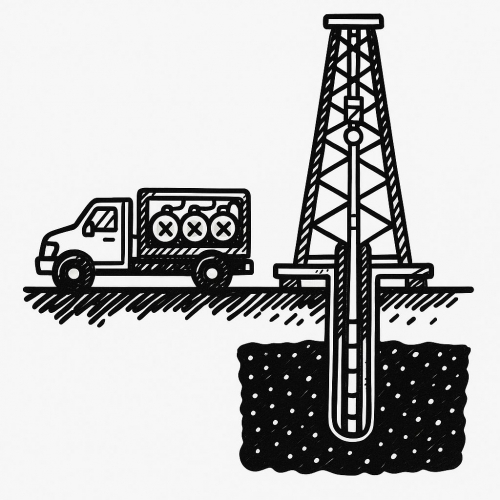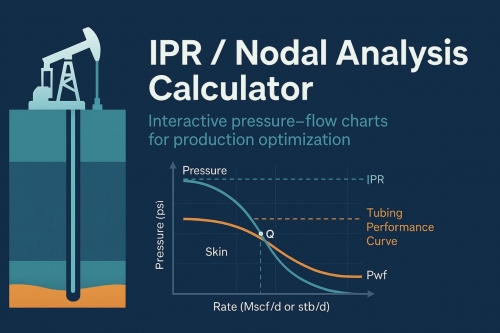The functions of a drilling fluid can be categorized as follows:
- Cuttings transport
- Clean under the bit
- Transport the cuttings up the borehole
- Release the cuttings at the surface without losing other beneficial materials
- Hold cuttings and weighting materials when circulation is interrupted
- Physicochemical functions
- Cooling and lubricating the rotating bit and drill string
- Fluid-loss control
- Wall the newly drilled wellbore with an impermeable cake for borehole support
- Reduce adverse and damaging effects on the formation around the wellbore
- Control subsurface pressure
- Support part of the drillstring and casing weight
- Ensure maximum logging information
- Transmit hydraulic horsepower to the rotating bit (Magcobar 1972)
Cuttings Transport. The drilling fluid should be able to remove rock fragments or cuttings from beneath the drilling bit, transport them up the wellbore drillstring annulus, and permit their separation at the surface using solids-control equipment. The density and viscosity of the drilling fluid are the properties that control the process of lifting particles that fall down through the flowing fluid by the effect of gravity. The fluid must also have the ability to form a gel-like structure to hold cuttings and weighting materials when circulation is interrupted.
Horizontal and high-angle wells require specialized fluid formulations and “sweep” protocols to minimize the risk of barite sag (in which the barite slurry separates downhole) and of low-side cuttings settling, both of which can lead to stuck pipe and loss of the well. The lubricity of the drilling fluid is also a key factor in controlling torque and drag in these types of operations.
Physicochemical Functions. The drilling-fluid system should remain stable when exposed to contaminants and hostile downhole conditions. Among the common natural contaminants are reactive drill solids, corrosive acid gases (e.g., H2S), saltwater flows, and evaporites (e.g., gypsum). The cement used in setting casing and liner strings is also a contaminant to some water-based muds. Wells in certain areas have extremely high bottomhole temperatures, at times approaching 500°F, and, likewise, arctic locations may expose the drilling fluid to subzero temperatures at surface.
Cooling and Lubricating the Rotating Bit and Drillstring. The drilling mud cools and lubricates when the rotating bit drills into the bottom of the hole and when the drillstring rotates against the wellbore walls. The fluid should have the ability to absorb the heat generated by the friction between metallic surfaces and formation. In addition, the fluid should not adversely affect the bit life nor increase the torque and drag between the drillstring and the borehole.
Fluid-Loss Control. The bit removes lateral support of the drilled wellbore and is immediately replaced by the drilling fl uid until the casing is set with cement. The stability of uncased sections of the borehole is achieved by a thin, low-permeability filter cake formed by the mud on the walls of the hole. Also, the cake seals pores and other openings in formations caused by the bit, thereby minimizing liquid loss into permeable formations.
Poor fluid-loss control can cause surge (an increase in wellbore pressure under a bit from running into the hole), swab (a decrease in wellbore pressure under a bit from running out of the hole), and circulation-pressure problems (known as ECD). Loss of circulation increases the drilling-fluid cost and the potential for the inflow of fluids (gas, oil, or water) from formations. High viscosity and high gel strength may cause excessive pressure in the borehole, as well.
The drilling fluid should not negatively affect the production of the fluid-bearing formation. That is, the drilling mud is designed to reduce adverse effects on formation around the wellbore. In contrast, the fluid must assist in the collection and interpretation of electrical-log information.
Control Subsurface Pressure. A drilling fluid is the first line of defense against well-control problems. The drilling fluid balances or overcomes formation pressures in the wellbore. Typically, this is accomplished with weighting agents such as barite, although there are other chemicals that can be used. In addition, surface pressure can be exerted to give the equivalent pressure needed to balance a formation pressure.
An overbalanced condition occurs when the drilling fluid exerts a higher pressure than the formation pressure. An underbalanced condition occurs when the drilling fluid exerts a lower pressure than the formation pressure. Therefore, in underbalanced drilling operations, the borehole is deliberately drilled with a fluid/pressure combination lower than the formation pressure. A balanced condition exists if the pressure exerted in the wellbore is equal to the formation pressure.
Help Support the Drillstring and Casing Weight. Any time a material is submerged in a fluid in a gravitational field, there is a reaction that offsets the force that gravity exerts. This is often called buoyancy, although there are a lot of misconceptions related to this term. Nonetheless, in heavily weighted situations, this “buoyancy force” can assist by offsetting some of the weight of a drillstring or casing. This offset is dependent upon the density of the fluid, with higher-density fluids giving more of an offset and lower density “fluids” (e.g., air) not helping much, if at all.
Ensure Maximum Logging Information. The drilling fluid has a profound impact on the electrical and acoustical properties of a rock. Because these properties are what logging tools measure, it is imperative that the correct selection of wireline logging tool or logging-while-drilling (LWD) tool for a given drilling fluid be made. Or, lacking that, then the correct drilling fluid must be used for a given logging tool. In addition, the drilling fluid should facilitate retrieval of information by means of cuttings analysis.
Transmit Hydraulic Horsepower to the Rotating Bit. The hydraulic force is transmitted to the rotating bit when the fluid is ejected through the bit nozzles at a very high velocity. This force moves the rock fragments or cuttings away from the drilled formation beneath the bit. In directional-drilling operations, the hydraulic force powers the downhole hydraulic motor and turns electric-power generators (turbines) for measurement-whiledrilling (MWD) and LWD drillstring equipment.

%20(1).png)



